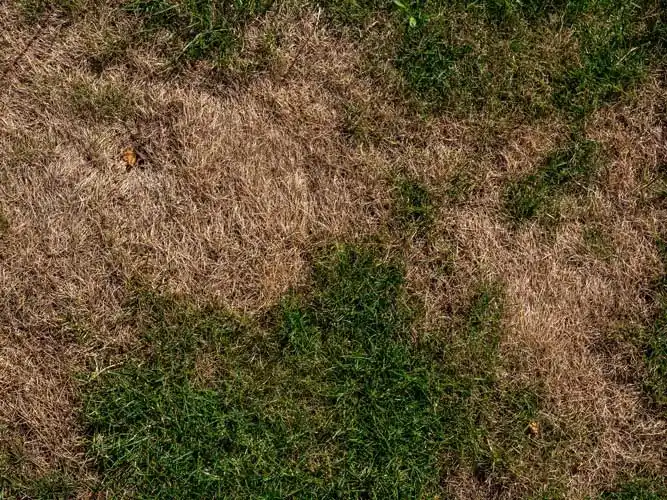What Should I Do If My Lawn is Dying?
There are a lot of possible reasons why your lawn is dying, so the first step you should take is determining what’s causing the health issues. Is it showing signs of overwatering? Are pests causing damage to the turf? Is the soil too compacted and making it difficult for your grass to uptake nutrients? Once you know the cause of your lawn’s health issues, it’ll be easier to create an effective care plan. Some of the most common lawn problems include:
Thatch or Soil Compaction
Soil compaction happens over time and eventually causes the dirt to become very hard. On the other hand, thatch is a buildup of decomposing organic material like dead leaves that rests on the top layer of the soil. Though these problems are different, they have the same effect on your lawn: they make it challenging for your grass to get the nutrients it needs. If you notice signs of these problems, try aerating the soil and removing the thatch buildup.

Lack of Nutrients
If your soil is void of nutrients, your grass won’t be able to grow thick and healthy. It’s a good idea to apply a fertilizer treatment at least twice per year to ensure your soil has everything your turf needs to thrive. We recommend fertilizing once in the spring to help your grass come out of dormancy, and once in the early fall to help it prepare for the cold weather ahead.
Improper Irrigation
Over and under watering your lawn can have adverse health effects in a short amount of time. Too much moisture will attract fungus and pests, and may contribute to a shallow root system. On the other hand, your turf will become brittle and frail if it’s not getting enough water. Try watering your lawn between 2 and 3 times per week for about 20 or 30 minutes, preferably first thing in the morning.
Need Lawn Care? We Can Help.
Click the button below to leave your information & we'll be in touch in an hour or less.
Pest Control Experts You Can Trust
Leave your information below and we’ll be in touch with your FREE quote!
"*" indicates required fields
*During normal business hours. After hours inquiries will be returned the next business day.
Poor Mowing Practices
From cutting the grass blades too short to using the wrong setting on your mower, it’s easy to make mistakes when trimming your lawn. To preserve your lawn’s health while mowing, follow these tips:
- Keep at least 2 ½ or 3 inches of length
- Avoid using the highest setting on your mower
- Replace your mower blades at least once annually
- Don’t mow a wet lawn
Infestation or Illness
Many lawns across Florida experience a pest infestation or fungus outbreak every once in a while. Keep an eye out for signs of external damage to your turf, such as bite marks on the grass blades or uneven brown patches across the lawn. If you suspect you have pests or fungus, contact an expert as quickly as possible to form a treatment plan.
Revitalize Your Lawn With Expert Help
If you’ve tried everything and your lawn is still wilting, then it may be time to call in a professional. Lawn care experts know how to diagnose and treat health issues with your lawn. The sooner you contact a professional, the easier it will be to get your grass back to optimal condition.
At Florida Pest Control, we’re proud to offer a full range of lawn care services to ensure your grass has everything it needs to flourish. With 75 years of experience serving Florida, you can expect tailored solutions that will bring your lawn back to life.
